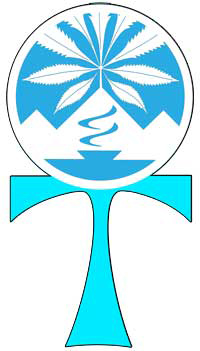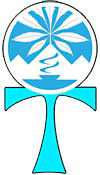defense
This page is a defense of my own personal religious beliefs and there may be no other human being in any universe of any time that agrees with me.
two opposites
I am defending my religion against two polar opposites: atheists and Abrahamic religions.
The ancient Egyptian (Kemetic) religion has lasted for a long time (exact length is subject to debate) and attempts to address questions common to most religions.
Of primary concern here are (1) the social and cultural aspects of the Kemetic religion, (2) the search for how to live, and (3) the nature of the aspect.
brief history
As a background, I am going to give a brief history of the ancient Egyptian (Kemetic) religion.
In the recent past there have been several brief periods of North Africa being a green verdant landscape, surrounded by longer periods of desert, on a 41,000 year cycle. This cycle may have been responsible for major waves of human migration out of Africa, including Home erectus (ssp. ergaster), Home heidelbergensis, and Homo sapiens sapiens out of Africa (at least twice).
The most recent verdant period was the African Humid Period between 11,000 and 5,000 years ago. North Africa had a large system of at least 127 major rivers, at least two major lakes, and inland deltas.
Throughout both the wet and dry periods, the Nile River continued to flow.
The ancient Egyptian religion is a subset of an older, more widely spread religion. Many of the artifacts of the older religion continued in the ancient Egyptian religion.
Prior to the most recent desertification the religion(s) of North Africa had the concept of totemic divine Goddess, some form of an afterlife, ritual worship of the divine, some form of attempts to understand nature, and some form of shamanic magic as an attempt to control nature.
During the time of the most recent desertification of the Sahara, shamans across North Africa used the local shamanic totem or religious symbol in an attempt to stop the spreading drought and bring back water.
All of these attempts failed other than the use of the Ankh in the Nile River valley. The ancient Egyptians viewed this as verification that their particular totem was real.
The ancient Egyptian religion continued through the pre-Pharaonic period as a tribal/shamanic religion and started to develop early versions of archetypal religion.
During the Pharaonic era the ancient Egyptian religion continued to develop new religious ideas (some borrowed from other surrounding religions and cultures), including elements of both modern Eastern and Western religion.
The ancient Egyptian religion also developed the earliest versions of both mathematics (certainly geometry and possibly trigonometry) and the earliest versions of science (the modern English word “chemistry” is derived from the name of the Kemetic deity Khem.).
change in religion
Members of Abrahamic religions tend to claim that any “true” religion is unchanging.
The fact is that all religions, including all Abrahamic religions, do in fact change over time. This is historical fact.
The Kemetic religion is comfortable with change. There is a sense of tradition, which has kept alive elements going back deep into prehistory, but there is also a willing acceptance of change and evolution.
The Kemetic religion has a long history of integrating new ideas, both borrowing from other religions and cultures and developing new ideas internally.
nature of the divine
The Kemetic concept of the nature of the divine has changed over time.
The Kemetic religion does have animistic, archetypal, and transcendental dieties, but viewed these as subsets of a greater definition of the divine.
The Kemetic word translated as the divine is “ntr”.
The concept of ntr is pantheistic. In the Kemetic religion, all of nature is the ultimate divine.
Atheists will question why have aduplicate word for nature and why not just use the secular terminology.
This dichotomy is an artifact of English. The English word “God” comes from the ancient Germanic word “Gott” and was introduced into the English language when the British people were converted to Christianity. The English language lacked a distinct word that matched the Christian conception of the divine.
The ancient Egyptian religion lacks a word for nature and lacks a word for the Kemetic religion.
Because the ancient Egyptians equated all of nature with the ultimate divine, there were not two separate words.
the nature of the divine
Like pretty much any people of any time, the ancient Egyptians struggled to understand how nature worked and how they could control (or at least survive) nature.
The earliest understandings were animistic and used shamanic/totemic approaches to dealing with nature.
The religion developed intricate systems of religious magic, including prayer and other ritual.
The religion also developed mathematics and science. Geometry was the first formal system of mathematics in the world. Additional advances in matehamtcis were developed by many societies, especially the ancient Egyptian, Sumerian/Babylonian, Indian, and later Phoenician, Chinese, and Greek.
Imhotep, who may have developed trignometry, proposed that mathematics were the rules by which ntr (the divine) interacted with humans.
The ancient Egyptian priesthood realized that only mathematics can be proven. All of science uses scientific induction and is therefore always probabilistic rather than proven.
From a practical point of view, highly verified scientific knowledge can very very useful, but it is not proven.
Because science is never proven, it is always open to change.
While some members of the Kemetic religion were highly conservative and traditional, most members of the Kemetic religion were open to new information and willing to change their religious and worldviews based on new information. This approach will upset members of the Abrahamic religions.
The Kemetic two primary views for understanding ntr (the divine) are reason (especially mathematics and science) and non-reason (especially feelings, intuition, and magic).
the two methods
The ancient Egyptians viewed the two primary methods of viewing and understanding of ntr (which is both the divine and all of nature) as Ma’at and Sekhem.
Ma’at is a complex idea, but for now let’s just define Ma’at as order and reason.
Sekhem is also a complex idea, but for now let’s just define Sekhem as intuition, feeligns, and creativity.
The Kemetic religion viewed the balance between Ma’at and Sekhem as the central question for living a positive life.
The ancient Egyptians believed that too much Ma’at resulted in a stilted and regimented life.
The ancient Egyptians believed too much Sekhem resulted in a chaotic and undisciplined life.
Most modern religions believe that the major struggle in living a positive life is the struggle between good and evil, typically with good and evil represented or personified by a divine or semi-divine being (such as Jesus and Satan).
The idea of good and evil did enter into the Kemetic religion by the New Kingdom, but was not the focus of the religion.
science and mathematics as religious ideas
The Abrahamic religions have a dogmatic claim that science and mathematics are inherently not religious concepts.
This religious dogma was introduced into Christianity in the 500s because the Christian authorities realized they wanted to make use of the engineering, scientific, and mathematical ideas of not just the Kemetic religion but of a variety of pagan religions.
Even today you will find that the U.S. federal court system uses the Meyers’ Test, created by a Roman Catholic federal judge, asserts that it is impossible for any science or mathematics to be part of any religion. Yes, the Christians have incorporated into the U.S. law Christian dogma and outlawed ancient religions and sent people to prison for violating that Christian dogma.
The Kemetic religion firmly includes science and mathematics as central religious beliefs. The two most famous members of the Kemetic priesthood were Imhotep, a priest of Ptah, and Hypatia, a priestess of Aset (Isis). Both Imhotep and Hypatia used science, mathematics, and reason as central tools in their religious practice. Imhotep probably created trigonometry. Hypatia probably created calculus.
afterlife
Most of the ideas about the afterlife in any religion come from the Kemetic religion. The Kemetic religion had both the heaven version of the afterlife and the reincarnation version of repeated life, with the heaven version being far more common.
The common view was that the soul went to Tuat after death. If the soul travelled through Tuat, the soul could be judged. At judgement the soul is either allowed into heaven or permanently destroyed. There was no version of hell or eternal punishment. Judgement was based on how the soul lived his or her life, not on the basis of faith.
In the Kemetic religion, the ability to live the afterlife in heaven was typically dependent upon the continued existence of the body (hence, mummification) and the continued memory of the person’s name (hence, the mortuaries).
The idea of a choice between heaven and hell was introduced by the Zoroastrianism (an ancient Persian religion).
Most of the ideas about heaven and afterlife in the Abrahmaic religions came from the Kemetic religion.
Over time, the Kemetic descriptions of the afterlife became more and more complex.
It is my personal opinion that there is no independent evidence of any afterlife of any kind. I personally hope there is a positive afterlife, but there is no proof. The increasingly intricate Kemetic descriptions of the afterlife seem to me to be a human invention out of fear of lack of continued existence (note that the ultimate punishment for those who were evil is the permanent end of existence).
There were many members of the Kemetic religion, including members of the priesthood, who believed that these descriptions of the afterlife were unsubstantiated and possibly false.
religious stories
The Kemetic religion had many religious stories, some of which appear in other religions, including Judaism, Christianity, Islam, Zoroastrianism, Hellenism, Hinduism, Celtic Druidism, Norse Asatru, and other world religions, often with the exact same names as the Kemetic original.
Certainly there were many members of the Kemetic religion who believed these stories as being literal history, but many members of the Kemetic religion viewed these stories as carrying religious meanings.
As just one example, while Judaism, Christianity, and Islam have only two creation myths (one from the Pygmies and one from the Mesopatamians), the Kemetic religion had more than 100 creation myths (including a version of the Pygmy creation myth closer to the Pygmy original). Most of the Kemetic creation myths include the Cosmic Lotus and the Cosmic Egg, but many of the creation myths are irreconcilably different. Members of the Kemetic religion had no problem with these different creation myths because they recognized these religious stories as carriers of deeper religious truths.
ka or ki or soul
The ancient Egyptians developed a seven-fold version of the human. In comparison, many Western religions have a three-fold human, body, mind, and soul.
One view is the ka, which is usually translated as soul, is part of the seven-fold human. There is no proof that the ka physically exists.
There is another view that the ka is an emergent force. The Chinese idea of the ki is a similar idea and there are claims that the Chinese ki is derived from the Egyptian ka, although the evidence of that claim seems to be very flimsy.
sin
Sin is a separation between a human and the divine. This is a concept originally developed in the Sumerian religion to explain why bad things happened to good people during the widespread wars between city states.
The Kemetic religion has no conept of sin. As with any pantheistic religion, there is no way for anything, including humans, to become separated from all of nature and all of nature (including humans) is divine.
slavery
The Kemetic religion did not practice human slavery. The ancient Egyptians were one of the few cultures in antiquity to reject human slavery. Human slavery was banned by the Kemetic religion.
Zahi Hawass, former Minister of Sate for Antiquities Affairs, talking about the 1990 discovery of the graves of the pyramid builders said, “No way would they have been buried so honorably if they were slaves.”
Amihai Mazar, professor at the Institute of Archaeology at the Hebrew University of Jerusalem, points out, “No Jews built the pyramids because Jews didn’t exist at the period when the pyramids were built.”
Zahi Hawass adds, “Then who built the Pyramids? It was the Egyptians who built the Pyramids. The Great Pyramid is dated with all the evidence, I’m telling you now, to 4,600 years, the reign of Khufu. The Great Pyramid of Khufu is one of 104 Pyramids in Egypt with superstructure, and there are 54 Pyramids with substructure. There is support that the builders of the Pyramids were Egyptians. They are not the Jews as has been said. They were not people from a lost civilization. They were not from outer space. They are Egyptian, tand their skeletons are here and were examined by scholars and doctors. The race of all the people we found are completely supporting that they are Egyptians.”
Zahi Hawass stated, “Building a pyramid was a national project involving the entire country. Every household in Egypt sent workers, grain, and food to contribute to this project, which enabled the king to become a god in the afterlife.”
Dieter Wildung, a former director of Berlin’s Egyptian Museum, said, “The myth of the slaves building pyramids is only the stuff of tabloids and Hollywood. The world simply could not believe the pyramids were built without oppression and forced labor, but out of loyalty to the pharaohs.”




